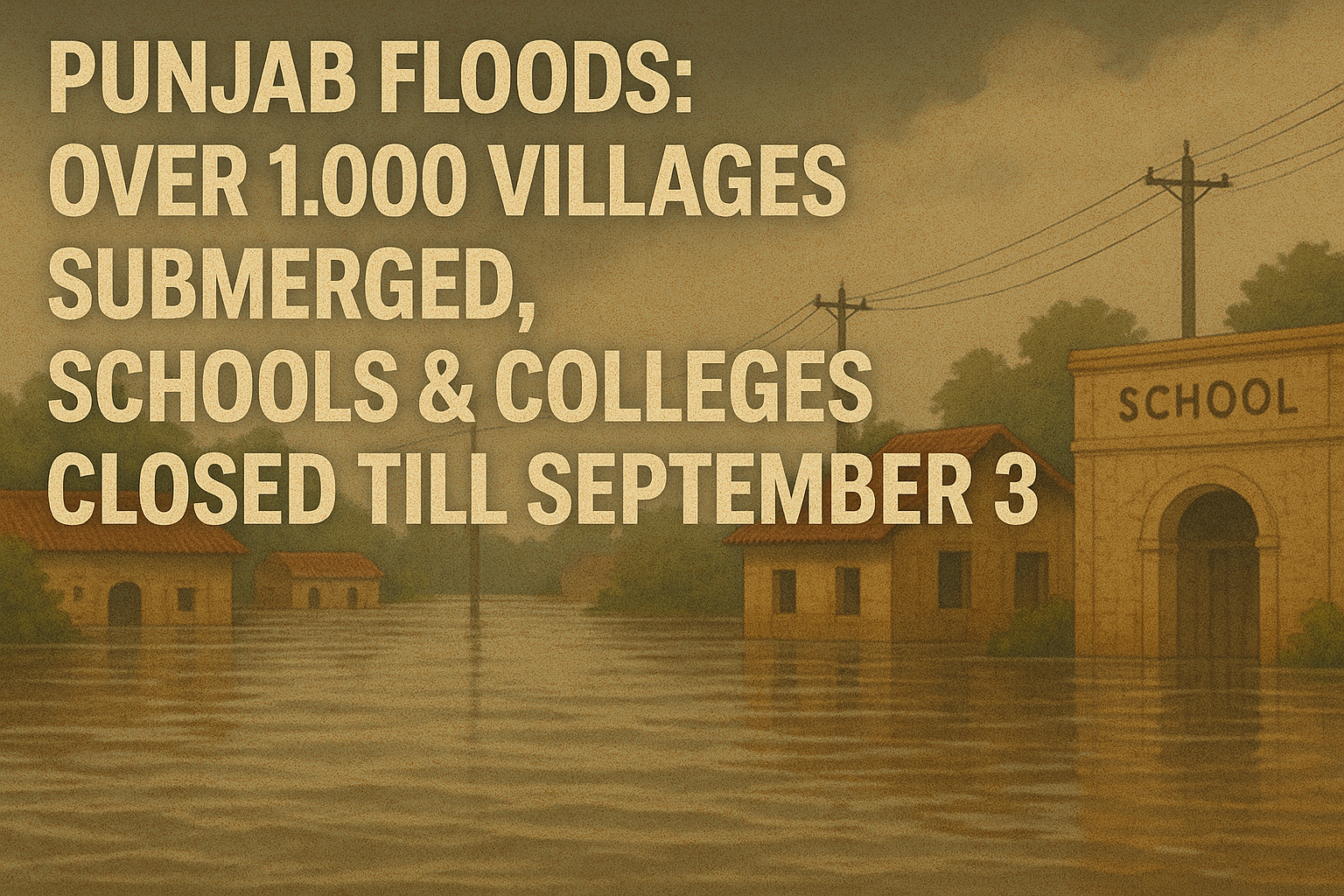
Punjab Floods: Torrential Rains Submerge Over 1,000 Villages, Rescue Operations Intensify
Chandigarh, September 1:
Relentless rains over the past few days have triggered devastating floods in Punjab, leaving more than 1,000 villages submerged across multiple districts. Thousands of acres of farmland lie destroyed, houses have been washed away, and families displaced, marking one of the most severe flood situations in the state in recent years.
According to the India Meteorological Department (IMD), Ludhiana recorded the highest rainfall on Monday at 216.7 mm, while several other districts witnessed heavy downpours. Patiala reported 80.4 mm, Rupnagar 82.5 mm, SBS Nagar 112.7 mm, and Mohali 64 mm. Other areas, including Amritsar, Pathankot, Bathinda, and Gurdaspur, also recorded significant rainfall.
The impact of the downpour was magnified as rivers Sutlej, Beas, and Ravi—along with several rivulets originating in Himachal Pradesh and Jammu & Kashmir—swelled beyond danger levels, inundating vast stretches of land in Punjab.
Districts Worst-Hit by the Floods
Floodwaters have wreaked havoc in Pathankot, Gurdaspur, Fazilka, Kapurthala, Tarn Taran, Ferozepur, Hoshiarpur, and Amritsar. In many areas, villages have been cut off due to overflowing rivers and damaged roads, making it difficult for rescue teams to reach affected populations.
Reports suggest that several houses have collapsed under the force of water, while farmers are staring at enormous losses as paddy fields, cotton crops, and other seasonal plantations are destroyed.
Massive Rescue and Relief Operations
So far, more than 11,000 people have been rescued from flood-affected regions across nine districts. Teams from the National Disaster Response Force (NDRF), State Disaster Relief Force (SDRF), and the Border Security Force (BSF) are working round-the-clock, in coordination with local police and district administrations, to evacuate stranded families and provide immediate relief.
Temporary shelters have been set up in schools and community halls, where food packets, drinking water, and medical assistance are being provided. However, ground reports indicate shortages in some areas, with villagers appealing for more support from the government.
Educational Institutes Closed Till September 3
In a significant precautionary step, the Punjab government announced the closure of all schools, colleges, universities, and polytechnic institutes till September 3.
Education Minister Harjot Singh Bains confirmed the decision in a social media post, citing student safety as the top priority. He added that administrations of institutions must ensure the well-being of students staying in hostels during this period.
IMD Issues Red Alert
The IMD has issued a red alert for several districts in Punjab, Haryana, and Chandigarh, warning of heavy to very heavy rainfall. Punjab districts under immediate threat include Patiala, Anandpur Sahib, Hoshiarpur, Nawanshahr, Kapurthala, and Ludhiana.
Experts warn that if rainfall continues in the upper catchments of Himachal Pradesh and Jammu & Kashmir, Punjab could see further swelling of rivers, worsening the flood crisis. Neighboring Haryana has also been placed under high alert, with Ambala and Panchkula expected to receive heavy rainfall.
Amit Shah Assures Central Support
Union Home Minister Amit Shah on Monday spoke to Punjab Governor Gulab Chand Kataria and Chief Minister Bhagwant Mann to review the situation. Both briefed him on the extensive damage and the measures being taken for relief.
Shah assured them of all necessary assistance from the Centre to deal with the disaster. The central government is closely monitoring developments and has kept additional NDRF teams on standby for deployment if needed.
Farmers Stare at Heavy Losses
While immediate attention is on human rescue and rehabilitation, the agriculture sector in Punjab has been hit hard. Large tracts of paddy and cotton crops have been destroyed, which experts believe could impact both local farmers and the state’s overall agricultural output this season.
With thousands of acres submerged, re-sowing may not be possible in many areas, raising concerns about long-term financial hardship for farming families.
Growing Anger Over Infrastructure and Preparedness
Many residents and motorists have voiced frustration over inadequate drainage systems and poor flood preparedness. In Ludhiana, where rainfall was the heaviest, people reported waterlogging lasting several hours.
Citizens also criticized delays in relief distribution in remote villages, with some alleging that government machinery was slow to respond. Calls to strengthen flood control infrastructure, including embankments and drainage channels, are growing louder.
The Road Ahead
With the monsoon season still active, Punjab remains vulnerable to further flooding. Authorities have urged people in low-lying areas to stay alert and avoid venturing near swollen rivers and canals.
The coming days will be critical, as more rain could aggravate the crisis. For now, Punjab’s resilience is being tested as rescue teams, farmers, and local communities fight against nature’s fury.


